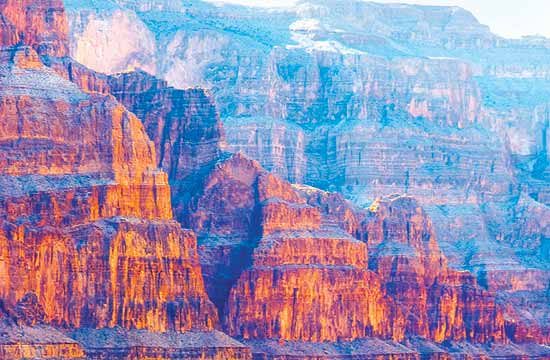I swear I’m not lying when I say I wasn’t interested in Vegas. I went there only because it is so close to the Grand Canyon. I did not need an alarm to wake up. Our group of six was the first to get picked up by the van sent by Papillon, the aviation company with which we were booked. On his two-way radio, the driver told his minders he had picked up the ‘six-pack’—this is the first time that term has been used for me in any context whatsoever.
At the little airport northwest of Sin City, I did not waste a minute on the souvenirs. I promptly made my way to the ticket counter to ask the woman manning it that I wanted the front window seat. Only after she confirmed my placement did I budge from the counter.
After a coffee and a short wait around the souvenir area, we were introduced to our pilot, a smart and courteous young man. He led us out to a spanking new helicopter, which had two seats in front next to the pilot, and four at the back. I shamelessly ran to stand next to the front gate, summoning all the experience I had gained in such matters while negotiating my seating position inside the school buses of my misspent childhood. I wasn’t going to risk a seat with anything but the best view. Dignity can wait in matters related to the Grand Canyon.
The first sight after the lift-off was of an elaborate sewage treatment plant close to the little airport. In the Mojave Desert, each drop of water counts. The pilot banked north and we got our first glimpse of the spectacular: the Hoover dam on the Colorado River, the lifeline of Las Vegas. We flew above the fringes of the dam’s vast reservoir, a testament to what human will can achieve against great odds.

All that paled into insignificance as we approached the canyon’s mouth. For no engineer of any calibre can make something like this. If you are a geology aficionado or have even a passing interest in rocks, this is the stuff of pilgrimage. The well-preserved rock formations are from times before multicellular life came about. For millions of years—at least 17 million, according to recent estimates—the Colorado River has carved this gorge. (For reference, consider that our humanoid ancestors branched away from chimpanzees only about seven million years ago.)
The erosion has provided a well-preserved cross-section of rocks, some of which are billions of years old. There is sandstone and marble and volcanic rocks. If you consider geology a subject for nerds—or agree with Sheldon Cooper of The Big Bang Theory, who considers geologists the Kardashians of the science world—this is still a breathtaking experience. If there is a patch of clouds around the sun, you won’t be blamed for thinking you have emerged from a chopper sequence of Apocalypse Now.

As such, the scale of the canyon is epic. To enter it in a helicopter gives a god’s view of this wonder. The Colorado seems like a little rivulet, its presence reduced by the gorge it has created. It is not often that a beautiful river gets so reduced to the background by surrounding rocks. The helicopter flew in the gorge for about 20 minutes and reached a wide point, where several helicopters were parked along a bare surface above the river’s south bank. As the helicopter swirled around before landing, we got a downstream view of the river, with the sun behind us. The river’s water was a muddy green. As soon as the chopper landed, I ran to the edge of the landing area to get a more expansive view; this patch of land for tourists inside the Grand Canyon National Park is courtesy the Native American tribes, for it is their land. A series of scenes form American western cinema flashed before my eyes. (The signature song from McKenna’s Gold came to mind: ‘Cause every mother’s son has got a date, a date with fate….’) While the others had breakfast at a tented accommodation near the landing area, I could not wrest myself away from the view.
One after another, helicopters with tourists were landing and taking off, adding to the charm. We had a little over an hour to hang around and soak in the views. This being springtime, the cacti were flowering pink and lilac, soliciting pollinators buzzing around like helicopters. I finally got back to the tent, where our pilot had transformed into a host, helping us with refreshments he had brought along. It was time to go.
The helicopters—of all tour companies—follow a circular route. They fly north to approach the canyon at its mouth, course upstream of the river to the landing area, and then return on a southern route. On the return leg, I sat in the rear seat. The helicopter rose above the gorge for the first time. Suddenly, the view reminds one that this is actually a plateau, which is why the Grand Canyon is such a special site. It drops from the top of the plateau to below sea level in some parts.
With the sun behind us, the light was kinder, even if the views were less impressive. I caught some recreational motorcyclists and drivers testing the desert sand. Downstream of the Hoover dam, the Colorado offers several water sports opportunities, which we surveyed from the air on the way back.
Back in Vegas, we rode the world’s highest Ferris wheel called the High Roller. The sights were impressive. But we’d seen better earlier in the day.
The information
Papillon (www.papillon.com) organises a variety of Grand Canyon tours either from Las Vegas or from within the Grand Canyon National Park. The Grand Canyon Celebration Tour ($484) lasts about 4.5 hours and includes flights to and from the canyon, hotel pick-up and drop, along with a champagne picnic and some time off for exploration.




